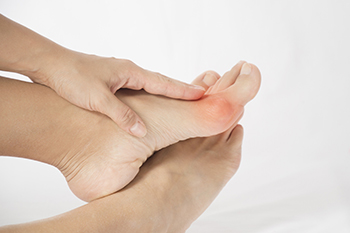
Bunions are bony bumps that form at the base of the big toe, causing the joint to stick out as the toe shifts inward. They often result from genetics, wearing tight or narrow shoes, flat feet, or arthritis. Bunions are more common in women, likely due to fashion footwear like high heels and pointed shoes. Over time, the misalignment worsens, leading to pain and inflammation. Symptoms include a visible bump on the side of the foot, swelling, redness, soreness, and limited movement of the big toe. It may feel like a dull, aching pain that worsens with walking or wearing certain shoes. A podiatrist may suggest shoe modifications, padding, custom orthotics, anti-inflammatory medications, or targeted exercises. In severe cases, surgery, called a bunionectomy, may be necessary to realign the toe joint. If you are dealing with a painful bunion, it is suggested that you schedule an appointment with a podiatrist for appropriate treatment.
If you are suffering from bunion pain, contact Gregory Kranzusch, DPM of Foot and Ankle Center of St. Charles County. Our doctors can provide the care you need to keep you pain-free and on your feet.
What Is a Bunion?
Bunions are painful bony bumps that usually develop on the inside of the foot at the joint of the big toe. As the deformity increases over time, it may become painful to walk and wear shoes. Women are more likely to exacerbate existing bunions since they often wear tight, narrow shoes that shift their toes together. Bunion pain can be relieved by wearing wider shoes with enough room for the toes.
Causes
- Genetics – some people inherit feet that are more prone to bunion development
- Inflammatory Conditions - rheumatoid arthritis and polio may cause bunion development
Symptoms
- Redness and inflammation
- Pain and tenderness
- Callus or corns on the bump
- Restricted motion in the big toe
In order to diagnose your bunion, your podiatrist may ask about your medical history, symptoms, and general health. Your doctor might also order an x-ray to take a closer look at your feet. Nonsurgical treatment options include orthotics, padding, icing, changes in footwear, and medication. If nonsurgical treatments don’t alleviate your bunion pain, surgery may be necessary.
If you have any questions, please feel free to contact our office located in St. Charles, MO . We offer the newest diagnostic and treatment technologies for all your foot care needs.
